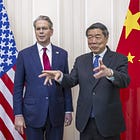China's self-sufficiency in 35 critical "stranglehold" technologies
What are they exactly, and to what extent has China achieved "self-sufficiency"?
"Stranglehold" technologies are critical industrial capabilities where dependence on foreign suppliers creates strategic vulnerabilities. Think semiconductors, advanced lithography machines, or aircraft engines—components so complex that few nations can produce them independently.
In 2018, Science and Technology Daily (the official newspaper of the Ministry of Science and Technology of China) identified 35 such "stranglehold" gaps. Since then, the U.S.-China rivalry has turned these technologies into geopolitical flashpoints. Export controls, sanctions, and supply chain weaponization have forced China to accelerate its quest for self-sufficiency.
By 2025, China has broken foreign monopolies in 60-70% of these areas—from heavy-duty gas turbines to LiDAR systems—yet remains locked out of cutting-edge domains like EUV lithography and biotech tools. Washington’s escalating restrictions have not only reshaped global tech flows but also fueled Beijing’s narrative of "innovation under siege."
How much progress has China truly made so far? Can it bypass Western barriers through alternative R&D pathways?
To answer these questions, today we translate an article that presents the latest breakthroughs and areas of dependency of China in all 35 critical technologies.
China's progress of 35 key “stranglehold” technologies
In 2018, Science and Technology Daily (the official newspaper of the Ministry of Science and Technology of the People's Republic of China), identified 35 critical technologies constraining China’s industrial development—ranging from lithography machines and semiconductors to aircraft engine nacelles and RF components. These “stranglehold” technologies were characterized by heavy reliance on imports, long R&D cycles, and high demands for cross-sectoral coordination.
As of May 2025, how far has China advanced in breaking these bottlenecks?
I. Technologies where China has achieved full or near-complete substitution
Heavy-Duty Gas Turbines
China has developed independent design and manufacturing capabilities, achieving breakthroughs not only in hot-end components but also in overall system technology—effectively reducing its reliance on foreign suppliers such as GE (U.S.) and Mitsubishi (Japan).
Aerospace-Grade Steel (e.g., 300M Ultra-High Strength Alloy)
The third-generation 300M steel has passed international certification and is now used in the landing gear of the C919 aircraft. It resolves key challenges such as purity in smelting and hydrogen embrittlement, marking a major step toward technological self-sufficiency and control.
LiDAR (Light Detection and Ranging)
Domestic producers such as Hesai Technology and RoboSense Technology are now competitive globally in autonomous driving, with performance metrics approaching international standards.
Vacuum Deposition Equipment
Chinese-made systems have achieved major breakthroughs in OLED panel production. Companies like SINEVA (Hefei) have launched high-precision deposition equipment, effectively challenging the longstanding dominance of Japan’s Canon Tokki.
Tactile Sensors
Array-type tactile sensors have been successfully developed and applied in industrial robotics, narrowing the technology gap with Japan.
Other fields
Domestic substitution has been realized in over 21 areas, including underwater connectors, battery separators, fuel cell materials, microspheres, and high-end bearing steel.
II. Technologies with partial breakthroughs but ongoing gaps
Lithography Machines
SMEE (Shanghai Micro Electronics Equipment) has delivered 28nm immersion lithography systems and aims for 14nm, but EUV machines (required for sub-5nm nodes) remain beyond reach. Core components like light sources and dual-stage systems still rely on imports.
Chip Manufacturing
SMIC (Semiconductor Manufacturing International Corporation) has achieved mass production at 14nm and begun risk trial production at 7nm, though yield and capacity still lag TSMC (Taiwan Semiconductor) and Samsung. Advanced packaging technologies such as chiplets are viewed as potential leapfrog opportunities.
Operating Systems
Huawei’s HarmonyOS now holds over 4% of the global market, but still lags Android and iOS in ecosystem maturity. On desktop, systems like UnionTech Unity Operating System (UOS) are gaining traction in government use, but have limited consumer adoption.
Industrial Software
Electronic Design Automation (EDA) tools, such as Huawei Gauss EDA suite, support chip design at 14nm and above, though they still lag behind U.S. firms like Synopsys in advanced process compatibility and algorithmic performance.
Aircraft Engines
The military-grade Shenyang WS-15 is now on par with the U.S. F119 in performance. However, the civilian ACAE CJ-1000A—intended for the C919—has yet to complete airworthiness certification and still relies on Western suppliers.
III. Technologies still dominated by foreign suppliers
EUV Lithography
Breakthroughs remain elusive in core technologies like extreme ultraviolet (EUV) light sources and high-precision optics. ASML maintains a global monopoly.
iCLIP Technology
A key biotechnology tool, iCLIP (individual-nucleotide resolution crossLinking and immunoprecipitation) remains underdeveloped in China, with slow progress in lab adoption and target screening efficiency.
High-End Scientific Instruments (e.g., Transmission Electron Microscopes)
Over 90% of high-end scientific equipment—including transmission electron microscopes and mass spectrometers—is still imported, with a wide performance gap in domestic alternatives.
Airworthiness Certification Systems
Airworthiness certification for China’s civil aircraft and engines remains subject to standards set by the FAA (U.S. Federal Aviation Administration) and EASA (European Union Aviation Safety Agency), underscoring the country’s limited voice in shaping international aviation regulations.
Ultra-Precision Polishing
Chemical Mechanical Polishing (CMP) tools and materials used in chip manufacturing remain heavily dependent on Japanese and American firms.
IV. Summary and Outlook
Roughly 60% to 70% of the 35 stranglehold technologies have seen meaningful breakthroughs or partial progress. Most unresolved areas are concentrated in semiconductor equipment, biopharmaceuticals, and high-precision instrumentation.
From a structural perspective, China’s path to overcoming stranglehold technologies has been driven primarily by “专精特新”(“specialized, refined, distinctive, and innovative” SMEs), supported by cross-sector collaborations—such as Huawei’s joint efforts with universities in EDA development—and targeted national funding programs like the “Big Fund” (China Integrated Circuit Industry Investment Fund) focused on semiconductors, all aimed at accelerating technological iteration.
Overall, China’s progress in tackling stranglehold technologies has shown encouraging momentum, characterized by breakthroughs across multiple domains and a deepening, multi-layered advancement. The effectiveness of its current strategy is increasingly evident.
That said, achieving long-term technological self-sufficiency remains a complex and time-intensive endeavor. Going forward, greater emphasis must be placed on strengthening basic research, improving the efficiency of technology commercialization, and fostering tighter coordination across the industrial value chain—all essential to consolidating China’s position in global innovation and competition.






